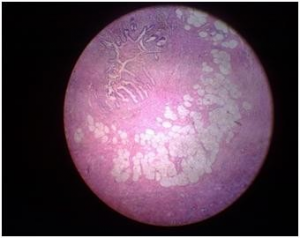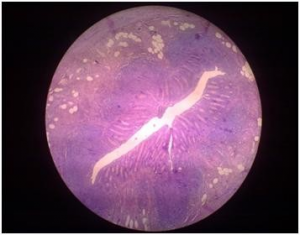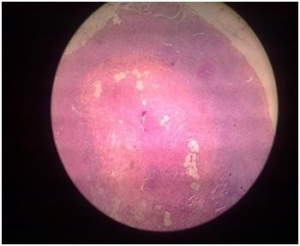International Journal of Anatomical Sciences 2012, 3(2): 33-35
Research Paper
Obliteration of the Lumen of the Vermiform Appendix
Swayam Jothi S, Jacintha Antony, Anuradha S, Hemanth Kommuru, Rajaeswara Rao N, Sujatha N.
Shri Sathya Sai Medical College and Research Institute, Ammapettai, Nellikuppam 603 108, Tamil Nadu, India.
Key words: Appendix. Obliteration of lumen, Lymphoid infiltration
Abstract: – The appendix being the common site for inflammation, an idea came to the mind that if the lumen is obliterated whether we can prevent inflammation. With this idea at the back of the mind a study was made in appendices which showed obliteration of the lumen or a very little lumen. 228 biopsy specimens sent to the pathology department of our college during the past 1 and 1/2 years were used for the study. We observed that 40 specimens showed narrowing of the lumen which was further classified into total obliteration which was observed in 12 specimens, slit like lumen in 21 cases and a very small lumen in 7 cases. The incidence was more in chronic inflammation and in males. The obliteration of the lumen of appendix was more common in the age group ranging from 20- 40 years during which time the lymphoid infiltration is also more due to repeated infections
The appendix being the common site for inflammation, the present study was carried out to analyze whether obliteration of lumen or very little lumen has any relation to inflammation.
Materials and Methods
228 biopsy specimens sent to the pathology department of our college during the past 1 and 1/2 years were made use for the study.
Observations
40 specimens showed narrowing of the lumen which was further classified into a very small lumen in 7(17.5%) cases (Fig. 1), slit like lumen in 21(52.5%) cases (Fig. 2) and total obliteration in 12(30%) specimens
(Fig. 3)
|
Table 1 The age incidence of obliteration of lumen in vermiform appendix
| Nature of Inflammation | No. of cases |
| Chronic | 32 |
| Acute | 066 |
| Actue in a previouslychronic condition | 02 |
The incidence of obliteration of the lumen was more in chronic inflammation (Table-2)
|
Table 3 Sex prevalence in obliteration of vermiform appendixThe sex prevalence is more (24 cases) in males and less (16 cases) in females (Table 3)Table 4 Length of appendices studied
|
The obliteration of the lumen of appendix was more in the shorter specimens whose length was not greater than 6 cm (Table-4)
Fig. 1 Appendix with small lumen
Discussion
Some of the findings reported by Collins (1936) were as follows: In a series of 1054 specimens 39% showed varying degrees of lumen obliteration; 61.4% were males and 38.5% were females. In the present study of 228 specimens, 40 cases (17.6%) showed varying degrees of obliteration. 60% were males and 40%were females. According to Collins (1936) there were 254 appendices (24.2%) less than 6cm in length. In this study, the shorter specimens revealed higher percentage of obliteration than those specimens whose length was more than 6cm.In the present study there were 32(80%) appendices less than 6cm in length out of 40 appendix specimens. The incidence of obliteration of appendix lumen was more in chronic appendicitis which was also associated with lymphoid proliferation. Maximow (1930), Palmer and Higgins (1993) all agree that fibroblasts may arise from lymphocytes. Mallory (1929) has clearly shown that endothelium also serves as a source of reticulum production. These two cellular elements are important factors in the production of obliteration
Fig. 2 Appendix with slit like lumen
Fig 3 Appendix with obliterated lumen Jothi SD. Obliteration of the lumen of the vermiform appendix
Conclusion
The age of incidence ranged from 20–40 years. This is too early for physiological involution of the lumen of appendix. The presence of varying number of lymphoid follicles and higher incidence of occlusion in chronic appendicitis favors inflammatory cause for obliteration of lumen. If appendix inflammation can be managed conservatively it may lead to occlusion of lumen of appendix. The obliteration of the lumen of appendix was more common in age group ranging from 20-40 years during which time the lymphoid infiltration is also more due to repeated infection.
References Collins DC (1936) Mechanism and significance of obliteration of the lumen of the vermiform appendix. Annals of Surgery, 104: 199–211.
Mallory, FB (1929) The principles of pathologic
History, Philadelphia, W.B. Saunders Co. pp 486-487.
Maximow, Alexander: (1930) A text – book of histology, Philadelphia, W.B. Saunders Co. PP.117–150,
Palmer BM and Higgins GM (1993) A study of the clasmatocytes in the Sacrospinalis Muscle of the Rabit. Am. J Med Sci, 85:191-196,



